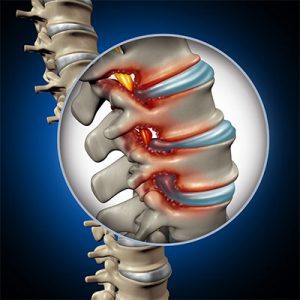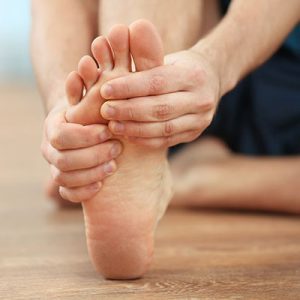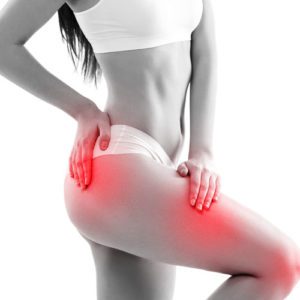Can Bad Posture Cause Chest Pain?
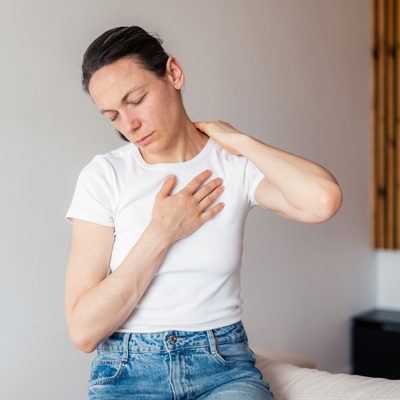
Yes, bad posture can absolutely cause chest pain. Poor posture is one of the most overlooked causes of chest discomfort, yet it affects millions of people worldwide.
However, here’s what’s crucial – while slouching chest pain is real and treatable, we must always rule out serious heart conditions first. Your safety comes first, always.
Today, we’ll walk through everything you need to know about the posture-chest pain connection, when to worry, and most importantly, how to find relief.
What Does “Bad Posture” Really Mean?
Let’s be honest – most of us have terrible posture. Between desk jobs, smartphones, and Netflix marathons, our bodies are paying the price.
- Rounded shoulders happen when your shoulders roll forward like you’re permanently hugging an invisible beach ball. This position pulls your chest muscles tight and stretches your upper back into weakness.
- Forward head posture occurs when your head juts out past your shoulders. Think about how you lean toward your computer or crane your neck to check your phone. This creates a chain reaction of problems down your spine.
- The classic slouch involves your entire upper body collapsing inward. Your chest caves in, your shoulders round forward, and your spine curves into a question mark shape.
How Your Posture Affects Your Chest
Here’s where things get interesting. Your ribcage isn’t just a protective cage – it’s a dynamic breathing machine. When you slouch, you’re literally squishing this machine.
Your diaphragm, the main breathing muscle, can’t work properly when compressed. Meanwhile, your chest wall muscles become tight and restricted, creating the perfect storm for discomfort.
How Poor Posture Creates Chest Pain
The Muscle Imbalance Game
Poor posture creates tight chest muscles (your pectoralis major and minor) while weakening your upper back muscles (rhomboids and middle trapezius). This imbalance pulls your shoulders forward and creates constant tension across your chest.
Over time, these tight muscles develop trigger points – those nasty knots that refer pain to other areas. A trigger point in your chest muscle can create pain that feels like it’s coming from your heart.
Nerve Compression: The Hidden Troublemaker
Here’s something most people don’t realize – poor posture can pinch nerves that send signals to your chest. When your spine is out of alignment, it can compress nerves in your thoracic spine and neck.
Dr. Bogduk’s research on spinal pain mechanisms found that thoracic nerve compression can create referred pain patterns that mimic cardiac symptoms. This means nerve irritation in your mid-back can actually cause chest pain.
Additionally, poor posture can compress the brachial plexus – a network of nerves that control your arms and chest. This compression often creates the sharp, shooting pains that make people worry about their heart.
Breathing Problems That Hurt
When you can’t breathe properly, your body rebels. Poor posture restricts your breathing mechanics in several ways.
First, it prevents your ribcage from expanding fully during inhalation. Second, it forces your diaphragm to work overtime in a cramped space. Finally, it makes your accessory breathing muscles (in your neck and shoulders) work harder than they should.
This compensation pattern creates a vicious cycle. Your breathing becomes shallow and inefficient, which increases anxiety and muscle tension, which worsens your posture, which restricts your breathing even more.
Common Posture-Related Conditions
Upper Crossed Syndrome is like the poster child of modern posture problems. It involves tight chest and neck muscles combined with weak deep neck flexors and middle trapezius muscles. The result? Chronic chest tightness and pain.
Thoracic Outlet Syndrome happens when blood vessels or nerves get squeezed between your collarbone and first rib. Poor posture makes this compression worse, leading to chest pain that can feel alarming.
Precordial Catch Syndrome causes sharp, stabbing chest pain that’s completely harmless but terrifying. It’s often triggered by sudden movements or poor posture that irritates the chest wall.
See more: Best Bras for Back Pain
Recognizing Posture-Related Chest Pain
What Does It Feel Like?
Posture-related chest pain has some telltale characteristics. It often feels like a dull ache or tightness across your chest, especially after long periods of sitting or computer work.
You might notice sharp pains when you move certain ways or try to straighten up after slouching. The pain often improves when you stretch, change positions, or take a deep breath.
Some people describe it as feeling like someone is sitting on their chest or like they’re wearing a tight vest. Others experience more localized pain around specific muscles or ribs.
Bad Posture vs Heart Pain: Know the Difference
This is the million-dollar question, isn’t it? Understanding the difference between anxiety vs posture chest pain and cardiac symptoms can literally save your life.
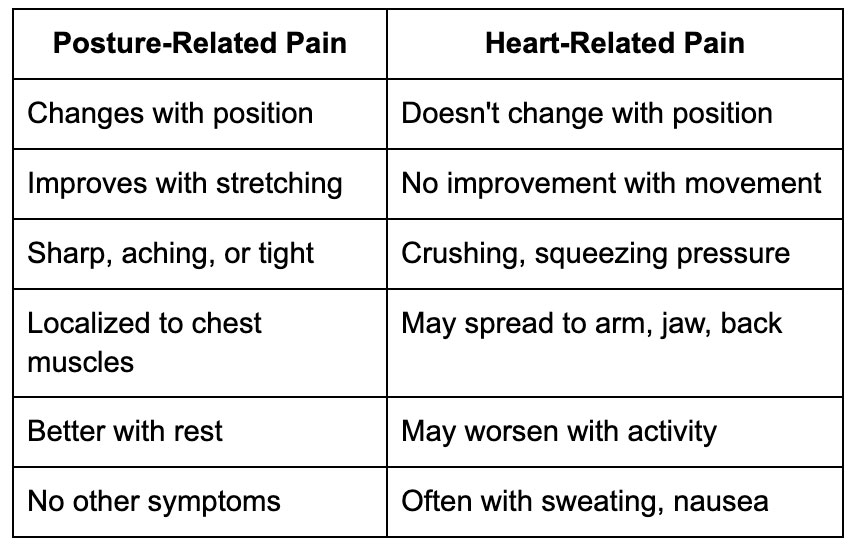
Left Side vs. Right Side: Does It Matter?
Many people panic more about left-sided chest pain because of heart attack fears. However, poor posture rib pain can absolutely affect either side of your chest.
Left-sided posture pain often relates to how your ribcage compresses and how your shoulder blade moves. Right-sided pain may be more connected to breathing mechanics and liver position.
The key isn’t which side hurts – it’s the character of the pain and associated symptoms that matter most.
Red Flag Symptoms: When to Call 911
We never mess around when it comes to chest pain. Call emergency services immediately if you experience:
- Crushing or squeezing chest pain
- Pain that radiates to your arm, jaw, or back
- Shortness of breath or trouble breathing
- Nausea, vomiting, or cold sweats
- Dizziness or lightheadedness
- Pain that doesn’t improve with rest or position changes
Remember, it’s always better to be safe than sorry. We’d rather see you in the ER for a false alarm than miss a real emergency.
Professional Treatment Options
Chiropractic Care: Our Specialty
As chiropractor Virginia Beach, we see the posture-chest pain connection daily. Spinal adjustments help restore proper joint motion and reduce nerve irritation that contributes to chest pain.
We also provide specific postural correction protocols that address the root cause of your problem. Our treatment plans often include soft tissue work, corrective exercises, and ergonomic recommendations.
Research by Dr. Evans published in the Journal of Chiropractic Medicine found that chiropractic care improved posture-related chest pain in 78% of patients within 6 weeks.
Physical Therapy Support
Physical therapists offer movement retraining and specific exercise programs to address muscle imbalances. They can also provide manual therapy techniques to improve tissue mobility.
Massage Therapy Benefits
Therapeutic massage helps release tight chest and shoulder muscles that contribute to postural problems. Deep tissue work and trigger point therapy can provide significant relief.
Regular massage can also help maintain the improvements you make with other treatments and prevent problems from returning.
Take Action for Your Health
The connection between posture and chest pain is real, common, and most importantly – treatable. Understanding this link empowers you to take control of your symptoms and prevent future problems.
At ChiroSolutions Center in Virginia Beach, we specialize in identifying and correcting the postural imbalances that create chest pain. Our comprehensive approach addresses both your immediate symptoms and the underlying causes.
Ready to breathe easier and feel better? Schedule your consultation with our team today. As Virginia Beach’s trusted chiropractic experts in the 23462 area, we’re committed to helping you achieve lasting relief and better health.
Your chest pain might be your body’s way of asking for help with your posture. Let’s listen to that message together and get you back to feeling your best.
FAQs
Can slouching cause chest tightness?
Absolutely. Slouching compresses your chest cavity and restricts breathing, leading to feelings of tightness and discomfort.
How quickly can posture correction help chest pain?
Some people notice improvement within days, but most see significant changes within 2-4 weeks of consistent effort.
Is chest pain from posture dangerous?
While posture-related chest pain isn’t dangerous itself, it’s important to rule out serious causes first. Always consult a healthcare provider for new chest pain.
Can stress and poor posture together cause chest pain?
Yes, stress often worsens muscle tension and breathing patterns, amplifying the effects of poor posture on chest pain.

Similar Posts
Free Initial Consultation
Stop living with pain and discomfort. Contact us to schedule your free initial appointment.
Request an appointment online, or call:
757-271-0001



